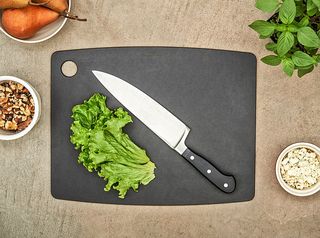 As a cutting surface, the boards from Epicurean are quite similar to the feel of of a soft maple wood cutting board. My sharp knives slide on the surface of the board without cutting in too far (but the board is soft enough that it doesn't wear down the blade like a bamboo board can). This is because Epicurean boards are made of a wood fiber composite and so feel very much like cutting on traditional wood instead of plastic or bamboo or glass. The boards are just 1/4-in thick which make them a lot less bulky than my thick wooden cutting boards. The thinness of the boards make them easy to dry. After hand washing a wood board, I used to have to set up a place to stand up the board to dry it (it was so thick it wouldn't sit nicely in any drying rack that I could buy). Sometimes, I would stick the wood board into an empty dishwasher (with the door open and the tray pulled out) to dry it. With the Epicurean boards, they are thin enough that I can stand the board up in the grooves/slots in a plastic drying rack on my counter. (The thinness also means that storing my four boards uses the same space as a single wood cutting board does. However, I use these boards so often that they never go into storage, and they just go directly from the drying rack to the counter to the sink and then back into the drying rack.)
As a cutting surface, the boards from Epicurean are quite similar to the feel of of a soft maple wood cutting board. My sharp knives slide on the surface of the board without cutting in too far (but the board is soft enough that it doesn't wear down the blade like a bamboo board can). This is because Epicurean boards are made of a wood fiber composite and so feel very much like cutting on traditional wood instead of plastic or bamboo or glass. The boards are just 1/4-in thick which make them a lot less bulky than my thick wooden cutting boards. The thinness of the boards make them easy to dry. After hand washing a wood board, I used to have to set up a place to stand up the board to dry it (it was so thick it wouldn't sit nicely in any drying rack that I could buy). Sometimes, I would stick the wood board into an empty dishwasher (with the door open and the tray pulled out) to dry it. With the Epicurean boards, they are thin enough that I can stand the board up in the grooves/slots in a plastic drying rack on my counter. (The thinness also means that storing my four boards uses the same space as a single wood cutting board does. However, I use these boards so often that they never go into storage, and they just go directly from the drying rack to the counter to the sink and then back into the drying rack.)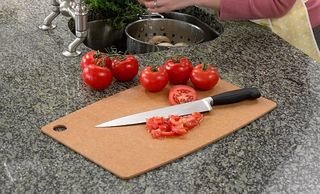 The wood fibers are layered and pressed into a food-safe resin which makes the board pretty dense and surprisingly heavy (the 14.5-in by 11.25-in board is about 1.5 pounds). After over six years of use, all my boards (which I purchased from Bed Bath & Beyond and Amazon.com) are still as flat as when I bought them. Not having to worry about warping (or oiling the board to keep them from cracking) makes using a wood board a lot easier.
The wood fibers are layered and pressed into a food-safe resin which makes the board pretty dense and surprisingly heavy (the 14.5-in by 11.25-in board is about 1.5 pounds). After over six years of use, all my boards (which I purchased from Bed Bath & Beyond and Amazon.com) are still as flat as when I bought them. Not having to worry about warping (or oiling the board to keep them from cracking) makes using a wood board a lot easier.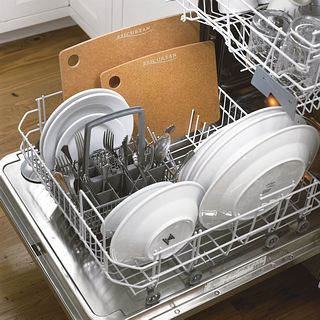 Epicurean cutting boards are dishwasher safe. In fact, they were specifically designed to fit most dishwashers. Even if you plan on hand washing the boards (which is what we do most of the time using just soap and water), I do recommend washing a brand new board in a dishwasher at least once. Sometimes a new board will have a smell from the food-safe wood glue used to to bind the wood fibers which I have found goes away after machine washing.
Epicurean cutting boards are dishwasher safe. In fact, they were specifically designed to fit most dishwashers. Even if you plan on hand washing the boards (which is what we do most of the time using just soap and water), I do recommend washing a brand new board in a dishwasher at least once. Sometimes a new board will have a smell from the food-safe wood glue used to to bind the wood fibers which I have found goes away after machine washing.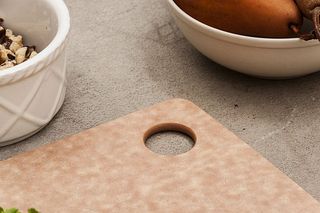 Each of the boards has an approx. one inch hole cut into a corner so they can be hung from a hook or rod for storage (or to dry), but I have not tried this. (The hole size ranges from 3/4 inch for the smallest board to 1-1/8 inch in diameter for the two larger board sizes. I don't have the 2nd smallest board size, but from photos it appears to have a hole the same size as the larger diameter ones.). The inside surface of the hole as well as the entire edge of the board is slightly rounded and very smooth and there is no risk of getting a splinter or a cut from running your fingers down the edge or around the hole.(which is what we do most of the time using soap and water)
Each of the boards has an approx. one inch hole cut into a corner so they can be hung from a hook or rod for storage (or to dry), but I have not tried this. (The hole size ranges from 3/4 inch for the smallest board to 1-1/8 inch in diameter for the two larger board sizes. I don't have the 2nd smallest board size, but from photos it appears to have a hole the same size as the larger diameter ones.). The inside surface of the hole as well as the entire edge of the board is slightly rounded and very smooth and there is no risk of getting a splinter or a cut from running your fingers down the edge or around the hole.(which is what we do most of the time using soap and water)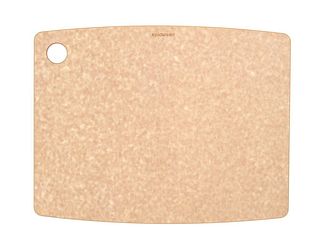 I have four boards. The largest one I have is a natural color 17.5-in by 13-in, and it works very well when I need to prepare a lot of ingredients or break down a chicken (or anything else that I prefer to have some more board space when working). I have both a natural and a slate colored 14.5-in by 11.25-in which get used more than any other cutting board (which is why I have two of them).
I have four boards. The largest one I have is a natural color 17.5-in by 13-in, and it works very well when I need to prepare a lot of ingredients or break down a chicken (or anything else that I prefer to have some more board space when working). I have both a natural and a slate colored 14.5-in by 11.25-in which get used more than any other cutting board (which is why I have two of them).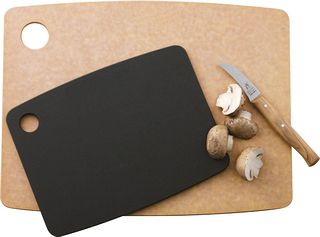 In addition to the 14.5-in by 11.25-in and 17.5-in by 13-in boards, I purchased a small cutting board (8-in by 6-in) about five years ago. I found that I wanted a smaller cutting board to use to cut small amounts of ingredients without dirtying a large cutting board. I reach for this one whenever I need to cut a lime, mince a few cloves of garlic, or slice a couple mushrooms.
In addition to the 14.5-in by 11.25-in and 17.5-in by 13-in boards, I purchased a small cutting board (8-in by 6-in) about five years ago. I found that I wanted a smaller cutting board to use to cut small amounts of ingredients without dirtying a large cutting board. I reach for this one whenever I need to cut a lime, mince a few cloves of garlic, or slice a couple mushrooms.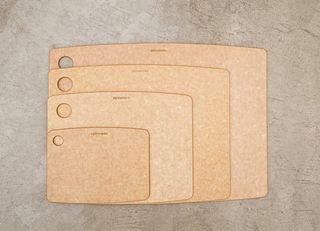 They have a fourth size that is larger than the smallest board I own and measures in at 11.5-in by 9-in.
They have a fourth size that is larger than the smallest board I own and measures in at 11.5-in by 9-in.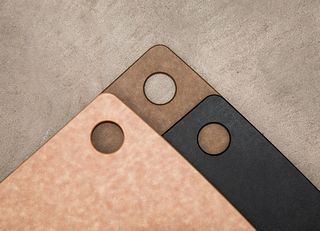 Something else nice about the cutting boards is that they can handle fairly high heat (up to 350°F) which means I don't have to reach for a trivet if I need to put a hot pot down on the counter and my board is already there.
Something else nice about the cutting boards is that they can handle fairly high heat (up to 350°F) which means I don't have to reach for a trivet if I need to put a hot pot down on the counter and my board is already there.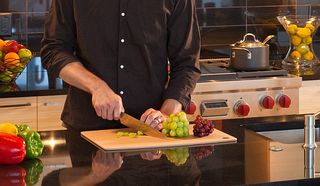 I've found that these boards have worked really well for me and the number of years which I have used them without having to take any special care (I just wash them and dry them - no salt rubs, vinegar, or oiling) means that I recommend them without reservation.
I've found that these boards have worked really well for me and the number of years which I have used them without having to take any special care (I just wash them and dry them - no salt rubs, vinegar, or oiling) means that I recommend them without reservation. The boards are available in three colors: Natural, Nutmeg, and Slate. I prefer the natural color when any heavy chopping or cutting is needed and would recommend getting a natural color board if you are only buying one. This is because, like all wood boards, over time small amount of wood fiber will come off the board. This is usually not noticable because wood boards tend to be light in color and the specks are very small, but a tiny speck of black board fiber can be easily noticed depending on the food being prepared.
The boards are available in three colors: Natural, Nutmeg, and Slate. I prefer the natural color when any heavy chopping or cutting is needed and would recommend getting a natural color board if you are only buying one. This is because, like all wood boards, over time small amount of wood fiber will come off the board. This is usually not noticable because wood boards tend to be light in color and the specks are very small, but a tiny speck of black board fiber can be easily noticed depending on the food being prepared.Related Articles

- Do you know if they are harder on knives than normal wood? I have touched som boards in a store, and had the feeling that they are much harder. They also contain a lot of glue, to my understanding, that some say is harsh on the edge of the knife.
- Have your tried the black ones? They have another composition, I think.
- It seems, a big brand is TopChef, making optical identical boards, somewhat cheaper. Have your tried them?
- Do you know if they have the same anti-bacterial properties as wood? This is the main reason I use wood for chicken and meat.
I don't know if they are harder on knives than normal wood. They do not seem to be. I have not found that I have needed to sharpen my knives any more often than when I was using regular wood. (So, if they are harder, then it is by a negligible amount.)
I own both black and natural (two boards of each). They might have different composition, but I have not noticed a significant difference between the boards. I really can't say if one is softer than the other from my experience.
I have not had an opportunity to try similar boards from TopChef.
I do not know for sure, but they do seem to clean easily and once dry do not appear to harbor any bacteria. They do have the added benefit that you can run them in a dishwasher which will usually be sufficient to sanitize the board if there is any doubt. I am a stickler for food safety in my house and have used my boards (except the small one) on meat and poultry for years now without incident. I don't know if this is useful information or not to you, but these boards are NSF certified.